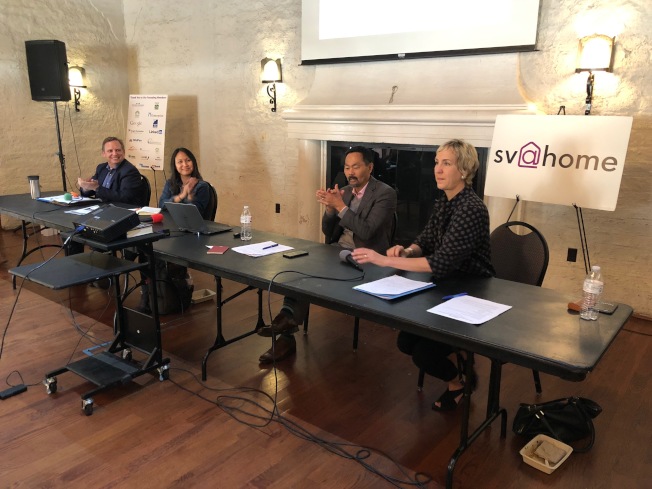Emily Lin of the Chinese language World Journal newspaper covered Silicon Valley at Home’s (SV@Home) April 26 forum on how Santa Clara County cities have been working to alleviate the South Bay’s housing crisis.
Read the English translation below or the original story at the World Journal.
Silicon Valley Experts Take Pulse of Housing Crisis
By Emily Lin
Silicon Valley@Home, an organization that promotes affordable housing in Silicon Valley, held a housing crisis forum on the 26th, inviting the deputy city manger of San Jose, Kim Walesh, and the vice mayor of Sunnyvale, Larry Klein. Elaine Uang, a member of the affordable housing development organization Palo Alto Forward, and Randal Tsuda, community development director of Mountain View, discussed the problems and solutions that local governments face in the housing crisis in Silicon Valley.
Klein said that the problems of transportation and housing in Silicon Valley are common in all cities. He said different cities have different regulations for development. For example, Sunnyvale funds affordable housing and other social benefits by charging retailers and companies different types of fees.
“All these issues are regional. All of our cities are facing very similar problems,” Klein said. “At the end of the day, what you’re trying to do is take the best ideas from each of the surrounding cities.”
Tsuda cited the recent development of North Bay Shore in Mountain View as an example of a very time consuming development process that needs to be communicated back and forth between the community, the city council, and various interest groups.
“We’ve taken all these lessons learned from North Bayshore and from many many years of this effort, and every time we do one of these we’ve learned,” Tsuda said. “We are doing a lot more of our scenario analysis up front [in East Whisman], trying to identify all those little levers and knobs that we can turn that will impact traffic and impact vehicle miles traveled.”
Those elements include the proportion of homes, retailers, and offices and how bicycle and parking decisions affect traffic.
“Economic growth and equity are absolutely interdependent and linked,” Walesh said.
She said that although San Jose is a big city in the Bay Area, development in the city’s downtown area has not progressed much until the recent development of the Google Technology Village. She pointed out that the technology village is not an ordinary high-tech campus but will be closely linked with the community through an urbanized open space.
“This is just a concept. We’re probably a good year away from there being any sort of project and probably two or three years away from there being any permits or development agreements, so in that is the opportunity to bring our best minds to this and create new models [of economic growth and equity].”
Uang said that residents in the Bay Area are concerned about housing issues, and she believes that there is a silent majority that supports housing, but most residents are unfamiliar with the process of housing development and do not know how to participate. She suggests that the public can start by participating in select city council meetings.
“Telling personal stories has been really effective,” said Uang. “We ask people to write letters, initiate petitions to aggregate voices. . .to show that there’s support when you aren’t actually there.”

